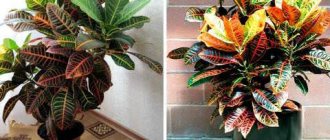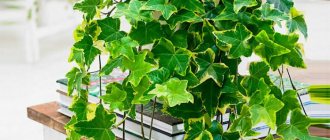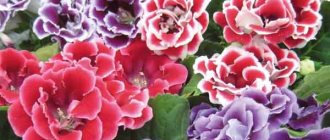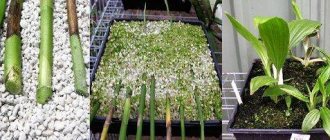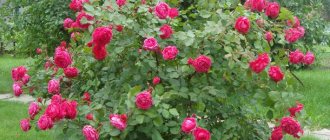- home
- Plant catalog
- Ampelous
Reading time: 12 minutes
15562
Kohleria is a small, perennial, profusely flowering bush.
It was named after the botany teacher Kohler from Zurich (19th century).
There are other names for the plant - fracture and tidea.
The homeland of Koleria is the tropics of Central and Latin America.
- Koleriya: varieties and photos
- Home care Lighting
- Temperature
- Watering
- Top dressing
- Transfer
Description of the range
Koleria is a perennial herbaceous plant . It is quite easy to grow, but for some reason it is not one of the most common flowers among flower lovers. Despite the fact that it blooms beautifully and the flowering period of the koleria is long.
The genus Kohleria Regel includes about 65 species of plants of the Gesneriev family . Distributed from Mexico to Central America, in Colombia, on the island of Trinidad. The name of the genus comes from the name of Michael Kohler, a science teacher from Zurich, who lived in the 19th century. Representatives of the genus are perennial herbaceous plants or subshrubs with scaly tuberous rhizomes.
The leaves are opposite, ovate-oblong, crenate along the edge, 12-15 cm long, up to 8 cm wide, with a densely fleecy surface . In different species, they can be either dark green with reddish veins, or olive green with a light central vein, shiny or ribbed, with thick white or reddish hair. The color of the leaves of hybrids can be either silver or bronze.
Colerias bloom very profusely . Flowers are solitary or 2-3 on an axillary peduncle. Campanulate corollas with a tube up to 5 cm, slightly swollen below, tapering towards the throat. Some flowers resemble thimbles. The wide-open pharynx has five blunt lobes, covered with numerous strokes, speckles, and dots. The color of flowers in natural species is varied: pink with a white throat with a thick dark pink speck, orange-red with a yellow throat with dark red spots; chestnut brown with white speckles and white throat with pink pattern, etc.
Kolerii are suitable for warm rooms, like Achimenes . Many hybrids have been obtained in culture as a result of interspecific crosses, mainly K. bogotensis, K. digitaliflora, K. amabilis and some other species; these hybrids are known by their respective names. Hybrids add cherry, fuchsia, golden, amethyst, green and even “tiger” shades to the color of flowers. In culture, standard, compact and miniature forms are known.
It is somewhat easier to keep kolerias than many other Gesneriaceae; they are less demanding on humidity and air temperature . The usual conditions in a residential apartment are suitable for them. You can buy Koleria seedlings at the Znak Zemlya plant nursery.
Popular breeders and series
Nature
Biologists regularly clarify the varieties of kohleria. A major revision was carried out in 1992. And in 2005, two varieties of Capanea were transferred to the genus Koleria. Coleria Karl Linden was promoted to the autonomous group Gloxinelle. At the end of the 20th century, an unusual type of epiphytically growing koleria with a woolly pubescence on the tube was discovered.
Interspecific hybrids number about ten; in natural conditions this is a common process. For example, Trinidad - obtained from crossing trumpets and hairy coleries.
Through the efforts of breeding masters, more than one hundred varieties have been created with individual plant sizes and extraordinary flower parameters, new colors and shapes, foliage with variegated colors and changed shapes. The abundance of flowering of selected varieties is usually higher, the habit is more compact, and the flower grows slowly, which preserves its decorative properties longer.
People
American breeders Patrick Worley, John Bogtan, Robinson Ma and Ralph created the Bristol's series of varieties, and Brandon Erickson created the Bud's varietal series.- Canadian James Ian - Peridot`s series.
- Taiwanese Vivien Liu, Rick Hang variety series, which they named after themselves. Alfredo Lin created the Designer series.
- Swedes Gunilla Svensson and Ivona Fors produced the Koleria variety series of the same name.
- Romanian breeder Serge Saliba and Czech Miloslav Malinowski also created varietal series of the same name.
The joint actions of man and nature increase the richness of the forms and colors of this bright and colorful flowering plant.
Reference! An interesting feature of the kohleria, changing the color tone of the flower as the bud opens, begins to play and shine even more with the help of the skillful intervention of breeders.
Features of growing koleria
- Temperature for koleria . Koleria prefers moderate temperatures. In summer 20-25 degrees C. If the plant stops flowering, i.e. enters a period of rest, it is better to reduce the temperature to 15 - 17 degrees C. When choosing a place for the garden, you must take into account that it does not like drafts.
- Lighting for coloring . Koleria is a light-loving plant. She needs a well-lit place, but in summer it should not be hot there and she should not be exposed to direct sunlight. During the dormant period, if the koleriya has not dropped its leaves, it also needs to be provided with good lighting.
- Watering the koleria . During the period of growth and flowering, i.e. from spring to autumn, watering should be done moderately. The soil should not be over-moistened, but drying out is also undesirable. In winter, watering must be reduced even more. If the above-ground part of the plant has died during the winter, the soil with the rhizome must also be periodically lightly moistened so that the rhizome does not dry out.
- Air humidity for koleria . Koleria can grow in dry air, but prefers a humid microclimate. However, its velvety leaves do not tolerate drops of water falling on them. Therefore, to create high humidity, it is necessary to spray not the plant itself, but the air around it, and also place the container with the color in a tray with wet moss or expanded clay. For watering and spraying, it is better to use soft, warm water.
Home care
Lighting
In order for Koleria to delight with flowers all year round, it must be provided with long daylight hours, but diffused light. It will feel great in the center of the room away from the window sills.
Temperature
For growing Koleria, room temperature in the range of 18-25 degrees Celsius is perfect.
Watering and humidity
Koleria bushes need to be watered with settled water at room temperature, through a tray. Avoid getting water on all parts of the plant. The frequency of watering depends on the room temperature - the lower it is, the less often water should be added. The soil in the pot should always be slightly moist, loose, but not waterlogged.
The air around Koleria should be humid. But, since direct contact with water is contraindicated for the plant, moisturizing devices should be kept near the pot with the plant - containers with water, humidifiers, wet pebbles.
Fertilizers
The soil with Koleria needs to be enriched with useful substances from early spring to late autumn once every 7-10 days. In winter, the flower does not need feeding.
Of the ready-made fertilizers, any store-bought mixtures for flowering indoor plants are suitable.
Priming
Young Koleria bushes are planted in an earthen mixture consisting of leaf soil and sand (4:1).
Flowers that are several years old prefer to grow in soil consisting of turf and leaf soil, river sand and humus (3: 2: 1: 1).
The bottom of the pot must be equipped with a good drainage layer. To prevent rot and fungal diseases of the root system, crushed charcoal should be added to both the substrate and drainage.
Transfer
The procedure for transplanting Koleria is carried out only if the tuber has grown greatly. At the same time, the new flower pot is chosen slightly wider than the previous one, without changing the depth.
The plant should be moved to a new container using the transfer method, being careful not to harm the root.
Diseases and pests of Koleria
Koleria is an unpretentious plant and is rarely affected by pests . However, aphids and spider mites may appear on the leaves and shoots, and the leaves and shoots begin to dry out and become deformed. Excessive soil moisture may cause rot.
It should also be remembered that Koleria is a delicate plant; when the leaves are mechanically touched and water gets on them, spots appear on them, the leaves begin to dry out and fall off, and the appearance of the plant deteriorates.
Mistakes and care problems
| Problem | Cause |
| Spots on leaf blades | Cold water was used for irrigation |
| Loss of leaf color | Either there is an oversaturation of fertilizers, or there are too many ultraviolet rays, and it is better to move the container with the plant further into the shade. |
| Folding a sheet | With loss of moisture and lack of nutrition |
| No flowering | Lack of rest period and waterlogging of the soil in the container |
Another video about proper care of caleria at home:
Coleria care
Plants with a pronounced dormant period . Blooms in summer and autumn. In summer they are kept in a warm, bright room with high air humidity, regularly fed with complete mineral or organic fertilizers, watered evenly, temperature 18-22 degrees. A sufficient amount of light is necessary, but light shading from direct sunlight. Spraying is not recommended, as drops of water leave unsightly spots on the pubescent leaves. In autumn, after flowering, watering is reduced. In winter, with the onset of the dormant period, the above-ground part of the plant dies. Rhizomes left in the ground are stored in a cool, dry place at a temperature of about 12-14°C. In the spring they are transplanted into a mixture of leaf and turf soil, peat and sand (2:1:0.5:0.5) in bowls or small pots with good drainage.
Propagated in spring by seeds obtained through artificial pollination, rhizomes and cuttings . Small seeds are sown without falling asleep in a mixture of peat and sand (1:1). The seedlings are planted twice - they are planted more freely, then the grown seedlings are planted one at a time in small pots. Cuttings are rooted in sand or a mixture of peat and sand (1:1).
Reproduction
Propagation by rhizomes is carried out only in the spring , when transplantation is carried out.
The koleria tuber is cut with a sharp knife into 1–3 lobes - rhizomes.
Each part is planted in a separate container. Watering should be done regularly until new shoots appear.
Propagation by rhizomes is not difficult and popular. This video shows in detail how to plant rhizomes after wintering:
Koleriya can be propagated by cuttings all year round . First, the cuttings are placed in water, then planted in the ground. When leaves appear, pinch it, waiting for side shoots to appear, until you get a neat bush.
Seeds can be obtained through artificial pollination. Afterwards, they should be poured onto the soil without crushing with substart. All the small sprouts are planted together in a small container, and the grown ones are planted in separate containers.
Propagation of koleria by stem cuttings is less popular, although this method is the most effective . The shoot is cut off and placed in a stack of water. In a week, roots will appear on it. The rooted cuttings should be planted in a small pot.
The decision to propagate our heroine with a leaf is more difficult. But this method is still used. One leaf needs to be placed in water for rooting. The first root on the leaf petiole will appear no earlier than after 3 months. Afterwards, the rooted leaf must be planted in a pot.
Types of colors
Koleria has a large number of varieties, including hybrid ones, bred through selective breeding.
- Bogota - with leaf blades of different shades of green, distinguished by jagged edges. The inflorescences are variegated: with a reddish-yellow outer part and a yellowish middle with scarlet dots. It blooms for a long time - almost the whole summer.
- The majestic plant has erect stems that are covered with reddish hair. The leaves are shiny, with a light white fluff. The flowers are quite large, deep orange in color, dotted with bright red dots and stripes of a dark red tone, deepening into the middle of the throat.
- Koloskovaya belongs to the low-growing Mexican varieties of Koleria. The plates of the plant have silvery soft fibers and are elongated in shape. The flowers are orange-red on the outside and yellow with scarlet splashes on the inside. They are formed alternately on a tall peduncle, like grains on a wheat spike, which is why the species gets its name.
- Coleria Lindena is native to the mountainous regions of Ecuador. The bush is squat, not exceeding 30 cm, with erect, unbranched shoots. The stems are covered with white hair. The leaf blades are slightly elongated, with a pale pink lower surface and green upper surface. The outer side is covered with light stripes located parallel to the veins of the leaf. The flowers are small, white-purple on top and yellow with brown specks inside.
- Foxglove belongs to the large species; the height of the flower can reach up to 80 cm. It has straight stems that bend over time. It has greenish leaves, located oppositely. Bell-shaped flowers with 5 petals, the outer part of which is white with purple stripes, and the inner part is light green with purple dots. The entire plant is covered with whitish delicate hair.
- Pleasant comes from Colombia, where this species has chosen the high mountain regions. The stems are a faint green color, covered with sparse whitish hairs. The leaf blades are oval-shaped, green with brownish veins and silver stripes. The outside of the flower is scarlet, and in the middle the tube is white with numerous purple dots.
- Fluffy-flowered , or Eriantha, is characterized by deep green leaves with a burgundy edge and covered with velvety hair. The flowers are orange or scarlet, the center is yellow, speckled with pink spots. This species is the most common among indoor varieties of kohleria.
- Tubeflower is native to Costa Rica and also Colombia. The shoots of the plant are single, straight, with oval green leaves with an elongated, sharp apex. The lower part of the leaf blades is reddish in color. The flowers are tubular, without an extended tip, like other species, and have a rich orange color.
- The woolen one is endowed with a thick shoot, covered with large green plates, pubescent with light brownish fibers. The plant blooms with delicate beige bells, with brown veins on the petals, with a white center covered with sparse beige stripes. All parts of the kohleria are covered with thick soft pile, which is why the species got its name.
- Ampallang - with tubular flowers of white and yellow color, densely covered with purple dots. Green leaves have darker veins.
- Qween Viktoria – with tube-shaped flowers. The outer side is soft pink, and the inner side is white with dark burgundy dashes and a pinkish edging.
- Sunshine - distinguished by medium-sized bright pink flowers with a yellow-green throat, replete with a scattering of purple stripes and specks.
- Bibbi is a plant with large pinkish-red flowers with slightly whitish petals. They are covered with cherry-colored dots, the throat is bright, yellow in color. The leaf blades are strongly inclined and have a slight green tint.
- Flashdance - blooms with impressive coral-colored buds, the petals and tube are yellowish-white with pink dashes.
- Brimstone - characterized by an unusual cherry-yellow color and a white tube. There are numerous inclusions of a pinkish-purple hue. The leaves are elongated and densely pubescent.
- Jester - with large inflorescences of a pale purple hue and a snow-white tube. The entire flower is abundantly strewn with pinkish inclusions. The leaves are dark green in color with beautiful bronze tints.
- Clytie is a plant with large red-pink flowers with dull white petals and a yellow throat. Decoration: cherry-colored stains. Leaf blades are light green in color with patterns.
- Koleria Varshevich - has large variegated flowers of a delicate pink shade with a tube and light green petals. The inclusions are purple.
- “ Uneven ” - belongs to the mini varieties. The flowers are elongated, of a dim burgundy color, with a throat covered with purple dashes.
- Manchu - leaves are light green in color, and the flowers are orange, which have burgundy specks on the bend.
- Sunny - has large yellow flowers interspersed with red, foliage is a discreet green shade.
- “ Carl Lindbergh ” has the darkest bud color of all the colors. The tube is a rich lavender color and the neck is white. The edges of the petals are dotted with dark crimson dots; closer to the base they become thicker and turn into horizontal stripes.
- Red Ryder - has drooping leaves that are dark green and deep red bells. All petals have dense dark cherry dots.
- Roundelay is a variety with pinkish-orange flowers. They are white inside, the petals at the bend are the same, only with small pink spots.
- " Persian carpet " - characterized by green leaf blades with a red border along the jagged edge. The flowers are velvety, large, with an interesting color: the top is reddish-crimson, the inside is yellow. The flap of the petals is the same color, but is also strewn with large dots of cherry color and has a crimson border. The flowering of this variety is abundant, and the formed bush has a neat circular shape.
- Rongo is a plant with light olive leaves covered with lighter veins. Purple flowers with a burgundy-speckled neck.
- Mother's Lipstick is a variety with very spectacular flowers: intense pink and dark burgundy combine harmoniously with snow-white splashes, creating the illusion of radiance.
- Sciadotydaea hybrid is a hybrid variety with large pinkish-scarlet buds covered with soft hairs. The beautiful dotted pattern on the outer part of the flower is gracefully offset by the dark green tone of the foliage.
- Cinnamon toast is a variety that has a velvety coating on the leaves and flowers. It belongs to tall crops, so it needs support. The flowers are multiple, coral-red.
- " Carnival " - refers to domestic varieties. It blooms profusely and for a long time with an orange-red palette.
- Emily Roberts is the owner of orange buds with a yellow center. The petals are crimson, with purple splashes.
- Peridot's Kitlope - Features a fluffy, bright orange tube. On the bend, the petals are pinkish-white, with burgundy specks.
Description and photos of varieties
Selected varieties of koleria are represented by a wide variety. They were bred through interspecific crosses and are unpretentious to keeping at home . In principle, growing different varieties of tropical beauties at home does not differ; the varieties of Koleria do not require a special approach.
Flashdance
Coloria Flashdance was bred in 2001 by a breeder from Sweden - Susanne Hvegholm.
Creamy-pink petals with a yellowish tint are dotted with raspberry-fuchsia speckles. A bright crimson edging runs along the edge of the flower. The foliage is moderate green.
Jester
The variety was bred in 1982 by breeder P. Worley. It was created by crossing two colors of Amabilis varieties Bogotensis and Eriantha/
On a straight, strong stem with dark, dense green leaves that fade into a bronze tone, large bells, white at the base and dark red along the length of the tube, bloom . On the bends the petals are white with a thick spray of pink-red spots. Dark pink strokes complement the color palette. The very bright flowering is emphasized by the fact that the spots merge into stripes-strokes, combining spontaneity and geometricity in color.
The foliage gently slopes downwards, its edges have a jagged edge. The bush itself is small, but blooms very profusely.
Karl Lindberg
Coleria Carl Lindbergh is one of the varieties with the darkest color. Densely dark lavender tubes, like velvet, are shaded by white necks and petals lightened white on the bends, dotted with burgundy-crimson splashes, thickening towards the base to a continuous horizontal line encircling the tube.
Queen Victoria
Koleria Queen Victoria is a very delicate floral arrangement with large, slightly pink flowers. The pink tone is emphasized by the white neck, bleached petals and thick beet dots with pink prints. The leaves are inclined downward, dark green in color.
Red Ryder
Large dark red bell-shaped tubes with a white neck and petals. Thick rays and dots of dark cherry and dark red flowers look enchanting. The leaves droop strongly downward and are a deep, dark green color.
Roundelay
Fiery orange and red bells with a delicate yellow-white throat and petals bleached on the bends are often dotted with rich pink-fuchsia splashes of varying sizes and framed by dark green foliage. The plant is compact and bright.
SRG's Persian Carpet
Created in 2013 by breeder S.Saliba. Persian Carpet means Persian carpet. The color is as rich in color and velvety as oriental motifs.
Large, velvety flowers of a simple shape in a red-crimson tone with a soft yellow neck. The sunny yellow limbs of the petals are decorated with large cherry-colored peas and shaded with a crimson edging made of thick dark pink spray. The spots in the yellow halo seem to glow, especially shining in the bright rays of the sun.
Jagged foliage of a dark green tone with a reddish border complements the showiness of the composition. It blooms profusely, and the bush itself is compact, developing in the form of a lush hat.
Sunny
Large yellow flowers, with red speckles and streaks radiating from the neck in the form of rays. Moderate green foliage with denticles. The plant is small, collected, and produces very abundant color.


